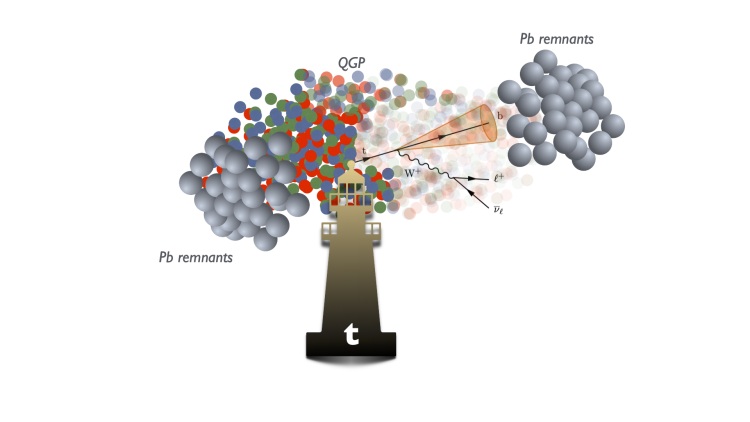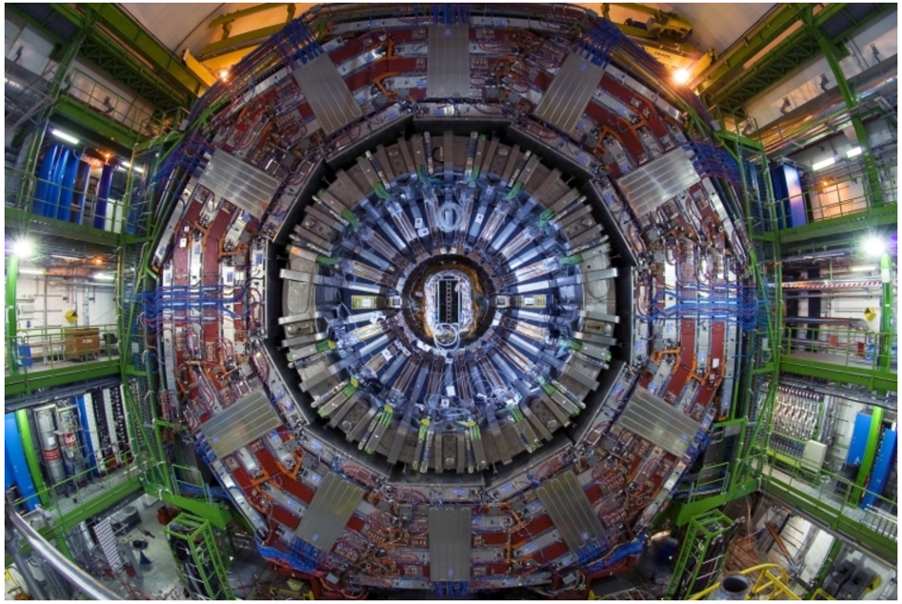
Five years after the first evidence that heavy metal hits the top quark, CMS now observes the clash of two titans with higher precision at unprecedented energy.
Using lead-lead collision data acquired in 2023 at the highest energy ever achieved by the LHC, the CMS experiment has performed a new measurement of the rate at which top quark pairs are produced. The results have an unprecedented precision, probing for the first time whether the production rate depends on how closely the ions interact. Spoiler alert: the results agree with the most accurate theory predictions… but we’ve only just begun.
A particle with a message
The top quark is in the heavyweight league of high energy physics, weighing almost as much as a gold nucleus. However, in contrast to atomic nuclei, which are composed of protons and neutrons and have physical dimensions of the order of 1-10 fermi, the top quark is an elementary particle and behaves as a point particle. Its production and properties have been largely studied in CMS in proton-proton collisions, and they are so well known that CMS researchers repurposed it as a lighthouse to shed light on what happens in collisions of lead ions, as illustrated above.
“Finding the top quark and measuring its properties is no simple business, it requires input from all CMS sub-detectors to identify all the decay products: jets, bottom-quark jets, leptons, missing energy. This complexity also opens new avenues to study the multiple effects present in heavy ion collisions in a controlled way” says André Ståhl, research physicist at CERN. Top quarks are predominantly produced via highly energetic QCD processes from the collision of a pair of nucleons. This is a regime where the Standard Model can benefit from better measurements to reduce the currently large uncertainties. The top quark can also be used to probe what happens just after the collision: color charges exist freely for a glimpse and lead to the formation of quark-gluon plasma as it would have existed shortly after the big bang. The decay products will travel through the plasma: bottom quarks are sensitive to the medium as they carry color charge, but that is not the case for leptons. You can think of these decay products in analogy to light rays and radio waves being emitted from the same source. Incoming heavy fog (the plasma) will dim the visible light (the bottom quarks) but the sound and radio waves (the leptons) will remain intact. Figure 1 shows a candidate event selected in the 2023 data, where both top quarks decay separately to a bottom quark and a W boson, which subsequently decays to a charged lepton and a neutrino.
Figure 1: An event display of a candidate signal reconstructed by the CMS detector.
Machine learning to the rescue
Electrons and muons are used as a guide for the selection of events from the collision data. Jets from the bottom quarks (b-jets) that survive the passage through the plasma give the final confirmation that top quarks have been produced. "Since multivariate analysis techniques have become the standard procedure for identifying jet flavour in proton–proton collisions, why not apply the same approach to heavy-ion collisions?" notes Sitian Qian, PhD student at Peking University, one of the main proponents of the Particle Transformer (ParT) algorithm. Notably, this analysis marks the first application of the ParT algorithm—originally developed for proton–proton collisions—to the heavy-ion environment, reducing the misidentification of non b-jets by a factor of 30 with respect to the algorithm used in the previous analysis.
What’s next
This study culminates in an inclusive cross section measurement for the production of top quark pairs with a precision of 21%, which rivals the current theory predictions, as shown in Fig. 2. An exciting road lays ahead with the larger luminosity to be collected until the end of Run 3 in 2026!

Figure 2: Comparison between the measured top quark-antiquark cross section (dashed vertical line with uncertainties shown as colored bands) and standard model predictions obtained using different models of the ion’s internal structure, known as nuclear parton distribution functions (black markers).
Written by: Pedro Ferreira da Silva, for the CMS Collaboration
Edited by: Andrés G. Delannoy
Read more about these results:
-
CMS Physics Analysis Summary (HIN-24-021): "Measurement of the top quark pair production cross section in PbPb collisions at √sNN = 5.36 TeV"
-
@CMSExperiment on social media: Bluesky - Facebook - Instagram - LinkedIn - TikTok - YouTube

